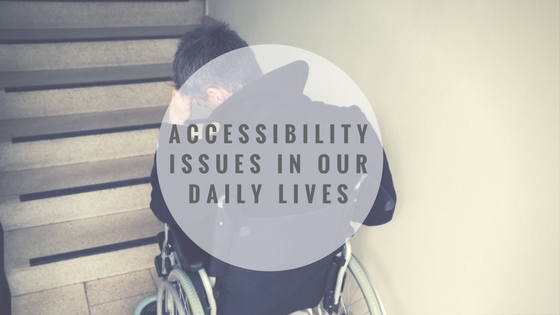Guest Blogger: Carolyn Rocca, Occupational Therapist
As I stroll into my favourite coffee shop to start my morning, I am reminded that this is a part of my day that I take for granted. Particularly, I am reminded of an observed experience that I encountered with a client who had a personal goal around using his walker to go into his favourite local coffee shop, something he had not been able to do since his brain injury.
After weeks of working up to this goal, it was finally time to assess his mobility in the community. As soon as we arrived at the coffee shop’s parking lot I could tell that this was going to be much more challenging than I had anticipated, as it quickly became apparent that there were several accessibility issues we would need to navigate.
Although the accessible parking spots provided us enough room to safely transfer out of the vehicle, and the ramp onto the side walk was graded appropriately, once up on the sidewalk, the client could sense a shallow slant in the pavement causing him to panic as he felt he was going to fall over. What became even more challenging was that there were no automatic doors at either entrance, and that the front entrance had a tightly-spaced vestibule with two sequential, single-passageway doors. On top of all of these challenges, there was about a 2-inch difference in the threshold of the door meaning the client had to lift his walker while already feeling nervous about the slanted pavement. Ultimately, the inaccessible nature of this establishment meant that it took over four people to safely get the client into the coffee shop, which not only increased his nervousness but also completely decreased his level of independence.
Although this experience was largely a success and the client was incredibly proud of what he had accomplished, it also brought to light some issues in our society. It was shocking that a well-established company (who shall remain nameless) had not yet invested in making all of their franchises accessible.
According to the updated accessibility requirements of the Ontario Building Code, buildings are required to have a barrier-free path of travel by having powered door operators at their entrances, meeting minimum requirements for doorway widths and ramp dimensions, and having adequate turning space (Ministry of Municipal Affairs, 2015). The unfortunate part is that these requirements do not affect existing buildings, and are only applied to newly constructed buildings or those undergoing extensive renovations.
What this means is that the current level of accessibility of this coffee shop will not be improved until this franchise decides to undergo major renovations. As a result, this franchise is not only impacting those who use gait aids or wheelchairs, it is also impacting individuals who have mobility challenges, low vision, and parents with strollers, to simply name a few. Additionally, according to the Royal Bank of Canada, people with disabilities have an estimated spending power of about $25 billion annually across Canada (Accessibility Ontario, 2017), meaning this franchise is also losing valuable business from a population who happens to love their coffee.
In being reminded of this experience, it also brings to light the impact that the profession of occupational therapy can have in terms of advocating for their clients needs and promoting equal access for all. Occupational Therapists (OTs) have a unique skill set in terms of assessing the needs of individuals, and identifying barriers in their environments that prevent their access or ability to engage in occupations that are important to them, such as grabbing a coffee. OTs teach people how to be proactive in their own lives, but bigger than this, also have the ability to communicate their clients’ / societies needs to others, and to offer solutions to barriers by involving appropriate stakeholders.
As such, I have written a letter to the coffee shop to bring awareness and attention to the challenges my client experienced while at their establishment. Moreover, in the future, I plan to examine buildings and public spaces beforehand to make sure I am helping my clients to be familiar with, and access, places that have the appropriate supports in place to maximize their level of safety and independence. In doing so, I will increase my clients’ future independence as they venture out without me, while also supporting businesses that have dedicated their time, effort, and resources to creating welcoming and barrier-free environments.
References
Accessibility Ontario (2017). About the Accessibility for Ontarians with Disabilities Act (AODA). Retrieved from https://accessontario.com/aoda/
Ministry of Municipal Affairs (2015). Overview of updated accessibility requirements. Retrieved from http://www.mah.gov.on.ca/Page10547.aspx

